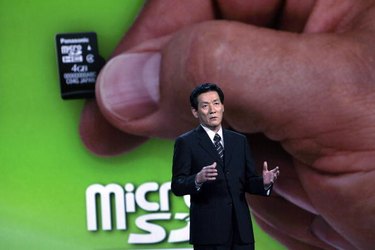
MicroSD cards are miniature versions of the Secure Digital flash storage format. They are used frequently with cell phones and other portable electronic devices. Most computers, however, do not have a microSD reader slot, leaving users unable to edit the files stored on their microSD cards. Luckily, most computers have either a USB port or a standard SD card slot, allowing you to use an adapter to gain access to the files stored on the microSD card.
MicroSD Card to SD Card Adapter
Video of the Day
Step 1
Lay the microSD card to SD card adapter face up on a flat surface.
Video of the Day
Step 2
Insert the microSD card into the slot on the side of the adapter with its contact points facing away from you. The exact location of the microSD card slot and the orientation of the card may vary from adapter to adapter, so review the instructions that came with your specific adapter for details.
Step 3
Insert the adapter into the SD card slot on the computer. The computer will now read the information stored on the card. You will be able to access this information by clicking on the storage device in the "Computer" section, if you are a Windows user. If you are a Mac user, it will be in the Finder window.
MicroSD to USB Adapter
Step 1
Lay the microSD to USB adapter face up on a flat surface.
Step 2
Insert the microSD card into the slot on the end of the adapter with its contact points facing away from you. The exact location of the microSD card slot and the orientation of the card may vary from adapter to adapter, so review the instructions that came with your specific adapter for details.
Step 3
Insert the adapter into the USB port on the computer. The computer will now read the information stored on the card. You will be able to access this information by clicking on the storage device in either the "Computer" section of your Windows system or the "Finder" window of your Mac.